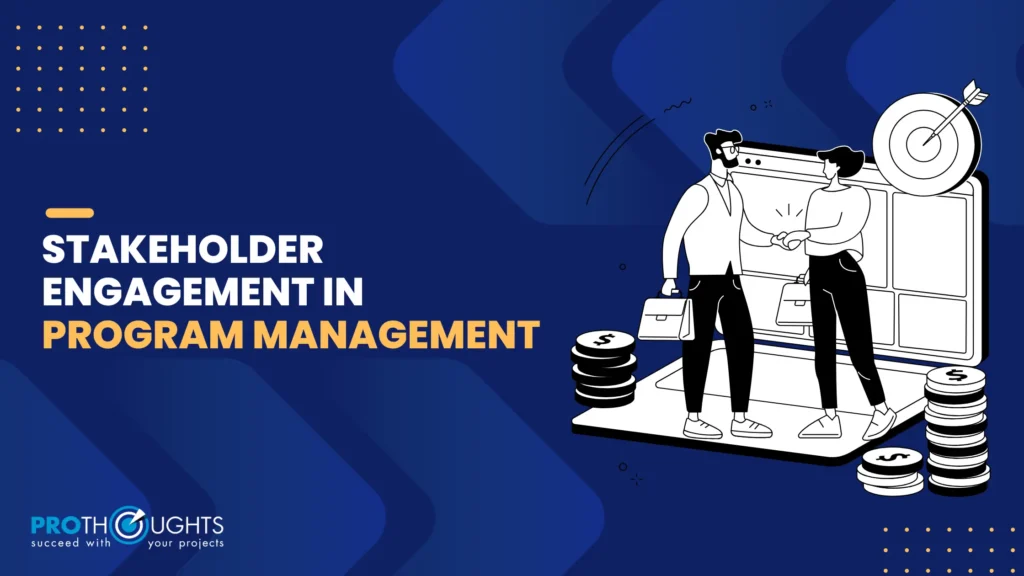
The stakeholder concept was first put to use at the Stanford Research Institute. It is said, “Organizations would cease to exist if groups’ support is not obtained”.
Later in the blog, I discussed some differences between Project and Program level stakeholders. The Program level stakeholders are not about managing pre-determined processes, but building rewarding relationships and influencing other people to help achieve the program goals.
Stakeholder Engagement in program management is always a two-way street, like many other things that we encounter in our professional and personal lives.
What do you want and what you can offer to the stakeholders that they value?
In Program Management or the way, it is done in PgMP Certification, the level of authority that the stakeholders exhibit over the Program. The manager can be very high. Unlike Project Managers, Program Managers lack authority over those they interact with.
A key aspect that you learn in PgMP training is to engage with a Stakeholder rather than managing the Stakeholder. The notion behind it is to understand the concerns and expectations of the stakeholders and focus on the right message, rather than the right method.
Below is the diagram that I have borrowed which clearly articulates the difference between engaging a Stakeholder and managing a Stakeholder.
The focus on stakeholder engagement in program management is clearly on delivering Business value while building rewarding relationships and bringing in Inspired Leadership, to influence others to achieve the Program Goals. However, stakeholder engagement in program management focuses more on the methods and processes to get it right.
It leads to another fundamental question why do we engage with stakeholders?
Why should we engage with the stakeholders?
I have tried to elaborate on the benefits of engaging and the risks of NOT engaging with the Stakeholders.
Benefits of Engaging with Stakeholders:
- Build more predictability on outcomes
- Build more rapport and trust
- More Organizational awareness
- Better equipped to deal with resistance from Stakeholders.
Similarly, the risks of not engaging with the Stakeholders
- Uncertainty of Outcome
- More rework as part of new changes coming
- Low Morale of the Program Management team
- This can lead to unprofessional and unethical ways of achieving goals.
Does a Program differ in the way it engages with Stakeholders from a Project?
The Program differs in the way it engages with Stakeholders from a Project that would In our PgMP certification or the PgMP Training, we clearly outline the differences between the both. What happens is that the PgMP training has people primarily coming from the Project Management background and they must unlearn some of the things before they learn the stakeholder engagement in Programs. Before becoming PgMP Certified one has to be seasoned with project management knowledge. Although there are similarities in the approach, there is a fundamental difference in approaching the stakeholders.
In a Program, the canvas is much wider than in a Project. However, the project’s stakeholders are more or less known and it does not pose such a challenge.
I have elaborated a few differences in the diagram below, which elucidates the
We have understood about engaging Stakeholders as per the PgMP Certification or Program Management. Let’s go a little deeper in understanding the steps in engaging with the stakeholders.
The Process of Engaging the Stakeholders
The Stakeholder engagement process in the PgMP certification / Program Management is one of the core things to do to engage stakeholders.
1. Identifying Stakeholders
In this stage, it is important to identify as many stakeholders as possible, first at a group level and then down to an individual level. It is necessary to identify individuals or sub-groups whose needs and expectations would be significantly different from the rest of the group and their level of influence can be major.
2. Classify the Stakeholders
It is important to classify the stakeholders to bring the focus on the stakeholders, effectively engage the key stakeholders accordingly, and achieve the strategic goals in a much better fashion.
There are many models to classify the stakeholders. I have elaborated a couple of the models below:
Power Interest Grid:
This is one of the most popular models for classifying the stakeholders. PMI has been used in the PgMP Training and guide to educate since the inception of PgMP certification in 2009.
The Grid is broken into 4 quadrants –
- High Interest, High Power
- High Interest, Low Power
- High Power, Low Interest
- Low Power, Low Interest
The below diagram is self-explanatory and the Program Manager with their team classify the stakeholders as 4 quadrants. Soon, you will discover your different stakeholders and will help to identify who are the key and most influential Stakeholders.
Further, depending on the stakeholders, as is evident from the diagram below, 80% of the efforts will be on the High Power, High Interest, and High Power, Low-Interest stakeholders. You typically build partnerships or strong relationships with the High Power, High-Interest stakeholders. For the rest of the quadrants such as High Interest, Low Power – you indulge in consulting to uncover their needs and use different communication tools to either pull or push communications.
3. Uncovering Stakeholder expectations
Now that the stakeholders are classified, the Program Manager needs to uncover the expectations of the stakeholders. Needs are explicit requirements from the stakeholders but the expectations are often undefined requirements and that’s a job for the Program Manager to handle. One of the big causes of failures of Program Management as stated in PgMP certification is the failure to satisfy the needs and expectations of the stakeholders.
The process is to find both the defined and undefined stakeholders’ requirements, at the individual level for key stakeholders and for others, at the group level. The idea is to define success and should include both hard benefits such as technical, operational benefits, etc, and soft benefits such as power, political benefits, etc. Many stakeholders do not express the soft benefits but they should be acknowledged by the Program Manager and team and should be documented as assumptions. These assumptions can be verified during the program. The PgMP training suggests that the expectations and needs of the stakeholders should be documented in a document – Stakeholder Register.
4. Negotiate Trade-offs with Stakeholders
Once the expectations are uncovered, the Program Management and the Program team need to evaluate the achievability of these expectations against the available capacity in the program. Any variance needs to be addressed and the trade-offs need to be negotiated with the stakeholders. As you cannot satisfy every stakeholder, the Program Manager will focus more on the key Stakeholders.
5. Get Buy-In from Stakeholders
Finally, the stakeholders must agree with the trade-offs and the benefits of the program. Once they agree, the Program Manager needs their commitment to the program. The stakeholders change over a while, some exit, and some new ones appear. Further, expectations and needs keep on changing during the program. Therefore, it becomes necessary that all these steps right from Identifying Stakeholders to getting the Buy-in from the stakeholders are a continuous process throughout the program. The buy-in and support from the stakeholders are of utmost importance for a successful program.
The stakeholder engagement in program management, therefore, becomes a continuous process and the stakeholder analysis and engagement should be in continuous iteration so that the buy-in from the stakeholders is always there.
Roles of Top Actors in PgMP Certification Program Management
There can be many actors in any Program. However, as per our PgMP certification,
we consider a few actors as the key stakeholders to help the program achieve its goals. The PgMP training goes into detail on what each actor in the Program can achieve.
Below is a brief idea of the actor’s role as a program manager.
Some Recent statistics on how Stakeholder Management is important for Program Management
As you are aware, Program Management is all about benefits realization and achieving the strategic goals for the organizations. In the entire process, the Program and its subcomponents, Projects, and Operations, focus on achieving the benefits to align with the strategic objectives of the organization.
Some of the statistics below suggest why Program Management can fill in the gaps in these statistics.
One primary statistic which is concerning and where Program Management will be effective:
- Lack of clear goals is the most common factor (37%) – Only 37% of the projects are successful and the rest are failures due to a lack of clear goals. In Programs, and as you learn from PgMP certification, this is one of the primary domains of Program Management.
Some other metrics can be useful to evaluate the effectiveness of Programs.
Further, if you analyze the causes of the failures, the top 2 are “Changes in Organization Priorities” and “Change in Project Objectives” and here, Program Management helps to fill in the gaps effectively. The PgMP Training focuses on these top 2 items effectively.
In this informative blog, we analyzed What is a Stakeholder, the difference between “Engagement” and “Management, discovered some ways to engage effectively with the stakeholder analyzed the differences between Project Stakeholder Engagement and Program Stakeholder Engagement, and identified the top key actors for Program Management. Finally, we glimpsed through some of the key statistics provided by top world bodies such as PMI and understood how Program Management can be the solution to help achieve the strategic objectives of the organization.
We will be happy to help in case of any suggestions/questions.
If you are keen to explore the PgMP certification, kindly visit our PgMP page and get detailed information on the PgMP Training.
You can also fix an appointment through our Calendar app with one of our PgMP training experts.




